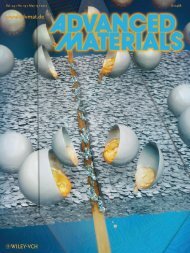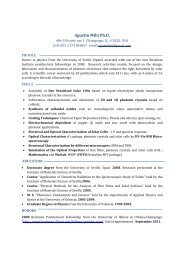Polymer Brushes for Molecular Transport - Paul Braun Research ...
Polymer Brushes for Molecular Transport - Paul Braun Research ...
Polymer Brushes for Molecular Transport - Paul Braun Research ...
You also want an ePaper? Increase the reach of your titles
YUMPU automatically turns print PDFs into web optimized ePapers that Google loves.
3.3.1 XPS characterization<br />
XPS was used to confirm both the <strong>for</strong>mation of the surface initiator on the silicon<br />
substrate and the successful polymerization of PNIPAAm. XPS was collected from the freshly<br />
cleaned silicon wafer, the APS-treated silicon wafer, the surface initiator, and the PNIPAAm<br />
brushes. In the spectrum of the clean silicon wafer, there was only one weak C 1s peak, likely<br />
due to organic contamination. After treatment with APS, both C 1s and N 1s peaks were<br />
observed and the intensity of C 1s was greater than on the bare substrate. Subsequent to grafting<br />
the initiator to the APS-treated substrate, the C 1s peak was at 285 eV, the N 1s peak was at<br />
400.1 eV and the Br 3d peak was at 68.8 eV. The N 1s and Br 3d peaks are presented in Figure<br />
3.2.<br />
After polymerization, the chemical composition of a 54 nm thick PNIPAAm brush was<br />
determined using XPS (Figure 3.3). The oxygen:nitrogen:carbon molar ratio was determined to<br />
be 11.3:12.0:76.4, which agrees with the expected value ratio of 12.5:12.5:75.0 <strong>for</strong> PNIPAAm<br />
(Figure 3.3(a)). The high resolution C 1s spectrum was fit with the 4 peaks expected <strong>for</strong><br />
PNIPAAm, resulting in a very close match to the experimentally observed spectrum (Figure<br />
3.3(b)). The sp 2 hybridized carbon atom in the carbonyl group, labeled IV in Figure 3.3(b), is at<br />
287.9 eV and has an integrated molar ratio of 15%, which is very close to the expected value<br />
(16.7%). The sp 3 hybridized carbon peak at 285.0 eV was divided into three components: peak I<br />
at 284.9 eV corresponding to the two CH3- groups in the isopropyl group and the -CH2- in the<br />
PNIPAAm backbone; peak II at 285.3 eV attributable to the -CH- unit in the PNIPAAm<br />
backbone; peak III at 286.2 eV corresponding to the -CH- unit adjacent to the -NH- group. A<br />
molar ratio of 3:1:1 <strong>for</strong> the three components, I:II:III, yielded a match to the overall shape of the<br />
36




